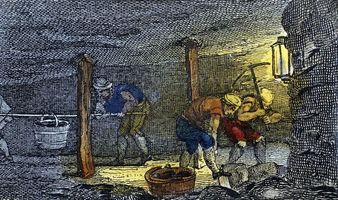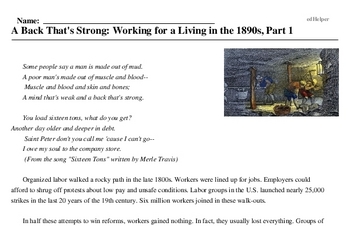A Back That's Strong: Working for a Living in the 1890s, Part 1
Some people say a man is made out of mud.
A poor man's made out of muscle and blood--
Muscle and blood and skin and bones;
A mind that's weak and a back that's strong.
You load sixteen tons, what do you get?
Another day older and deeper in debt.
Saint Peter don't you call me 'cause I can't go--
I owe my soul to the company store.
(From the song "Sixteen Tons" written by Merle Travis)
Organized labor walked a rocky path in the late 1800s. Workers were lined up for jobs. Employers could afford to shrug off protests about low pay and unsafe conditions. Labor groups in the U.S. launched nearly 25,000 strikes in the last 20 years of the 19th century. Six million workers joined in these walk-outs.
In half these attempts to win reforms, workers gained nothing. In fact, they usually lost everything. Groups of employers shared lists of those who had taken part in union activity. Workers from a failed strike were barred from other jobs. This was called blacklisting. In a few cases, employers made bargains with striking workers. These deals weren't backed by any sort of legal clout. Many didn't last long. Within a few month pay raises or other concessions often vanished like mist.
In spite of these disappointments, labor leaders pressed on. Most labor battles of the era followed a dismal pattern. The 1892 strike at a steel mill in Homestead, Pennsylvania, is an example. Faced with a cut in pay, the men banded together and walked off the job. Management moved to break the strike, bringing in new workers who didn't belong to the union. They also hired armed guards to keep union men out. Strikers, pushed to the wall, took up arms, too. In an exchange of bullets, several men were killed. The state militia was called in. Troops carried out orders to restore peace by pursuing and arresting strikers. The weary workers gave up. The strike was broken and the union collapsed.
Out west, the intensity of labor battles made it seem like the "Wild West" was alive again. Union issues were bringing miners and mine owners to blows. One hot spot was the Coeur d'Alene (Core duhLAYN) region of Northern Idaho. Silver was king here amid the tall timber and rugged slopes. The mountains of this remote area were peppered with the precious metal. In earlier days, lone prospectors had wandered the hills, searching for flakes of colored rock. Each had hoped to find a lush vein of ore and strike it rich.



